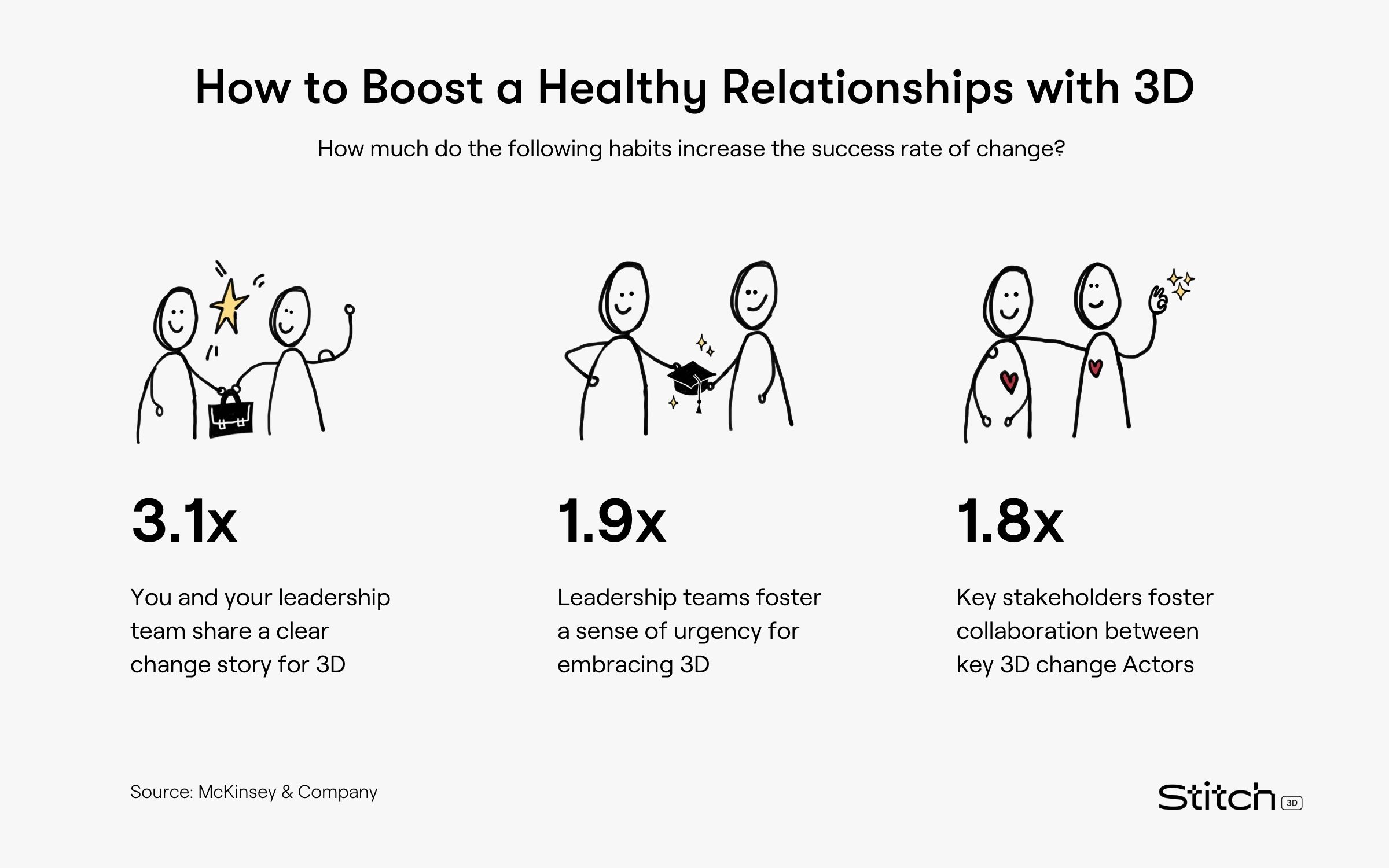People are losing motivation. 2D workloads aren’t getting any smaller and people don’t have enough time to learn 3D. Sounds familiar? 3D implementation is top of mind for many brands, but the initial excitement is dwindling and with it, the pace of adoption. Why did we start this 3D journey again? Don’t we want 3D to succeed? We do! What’s happening is change management in motion.
Most people love what they can do with 3D, but aren’t sure yet how (and even if) they can make it work in the long run. In other words, the honeymoon phase with 3D is ending. It’s time to build a foundation that makes the relationship with 3D the real deal. Can you keep your love for 3D as interesting, exciting, and motivating as day one?
Successful change is not something we see often in 3D implementations. These projects start as experiments fueled by need, hype, and FOMO. All of these are great to run a pilot, but not enough to scale. Organizations - and individuals - need to invest in change management if they wish to scale 3D. In other words, they must become change-minded organizations before they can reach a 3D happily ever after story.
To have a long-term relationship with 3D, you must build a shared 3D change story.
Just like healthy relationships, you can’t just force anyone to move into 3D without time or context. People need time to understand and embrace 3D, especially if it means they’ll need to change how they work! Most importantly, they need to believe in it. When we believe in something, we become invested. We commit to it.
Change will often take us on bumpy roads, not highways. Sharing a common 3D purpose transforms the bumpy road into a shared experience, something where people can support and rely on each other. Organizations and individuals can define a shared 3D purpose, which in change management is called a change story.
A change story is a tool used to define and communicate a shared vision around a particular change initiative. It’s a collaborative way to build a shared strategic narrative to support people in your organization through change. Not many companies implementing 3D do this, which generates a gap between the expectations of end-users, implementers, and senior leadership. To define a change story around 3D, you’ll need to answer 3 questions:
Why do you want to implement 3D?
To answer this, think beyond what you need now. Instead, focus on the long-term value of implementing 3D in your organization. Is it about efficient collaboration or is it sustainability that will make it count? This will help you define how to link your 3D implementation to your company vision. This is important as you want 3D to become a part of your company’s vision so you can get stakeholders on board and scale 3D sustainably. Answering this question helps you bring your company's needs and ambitions together with 3D.
How do you find your organization's "why"?
- Know your company vision. You will have a harder time linking 3D to your company through efficiency if your company’s key focus is to become more sustainable.
- Look for a challenge that you need to address, and where you think implementing 3D may help. This could be that the approvals take too long and cause big production delays, or that each design team follows a different workflow, creating bottlenecks downstream with vendors, merchandising, and sales. If there’s no challenge, there’s no opportunity, so find it!
- Write down the consequences of not addressing this challenge. What will happen to your team/organization if you don't do it?
- Identify how solving this challenge can help you achieve your company vision.
What is blocking you from implementing 3D?
Don’t look for solutions just yet. Instead, look inside your company. Find any areas that may hold your 3D implementation back. When doing this, it’s good to keep an eye on 3 domains:
- People: are there stakeholders that may not see 3D in the same light as your company does or will the impact for them be bigger than for the rest?
- Processes: Is there anything in your go-to-market process may be counterproductive when implementing 3D?
- Infrastructure: Does your technology stack support your 3D goals? Does your network allow for cloud rendering? If not, can users render with their own machines?
Answer these questions honestly and transparently. Get people from different areas of your business to respond to it. You will need different perspectives to know if what you consider to be a blocker actually is one. This question will give you an idea of where your effort should be prioritized.
What’s in it for you by implementing 3D?
Now it’s time to talk about value! Not just for your organization, but also for each one of you inside it. It’s different to say that your company will become leaner than to say you want to give designers more time to design.
Each department has a role in implementing 3D and the impact of the implementation will be different for each. For this reason, define at least one value unlock per department. Answering this question per team will give them the assurance that they are driving the implementation of 3D. This question is about positioning and targeting your 3D story effectively.
Scaling 3D is about driving change, not implementing technology.
3D implementation is considered one of the top digital transformation priorities in fashion. However, just like with any digital transformation project, the term can be misleading for those implementing it. It makes it sound like digital has the leading role in it, yet research shows transformation needs something else to succeed.
Almost 70 percent of employees surveyed by McKinsey consider that stakeholders sharing their enthusiasm and new plans with the wider organization helped teams change. Furthermore, successful change seems to be 3x more likely to happen when teams establish a clear narrative for change. You see, people, and not technology, are sitting in the driver’s seat. Real change starts and scales with people.

Business of Fashion and McKinsey estimate investment in digital will double by 2030. Are you prepared to leverage this budget effectively? Can you make 3D a success across the entire value chain and not just for designers? What can you do to start AND scale these initiatives to last?
Close that excel. Tsst, don’t touch that Powerpoint. Instead:
- Gather your team and have an honest conversation.
- Build a story following these steps and share it with everyone else.
- Gather their feedback and refine it. Is everyone happy?
You got yourself a head start towards your 3D happily ever after ;)
